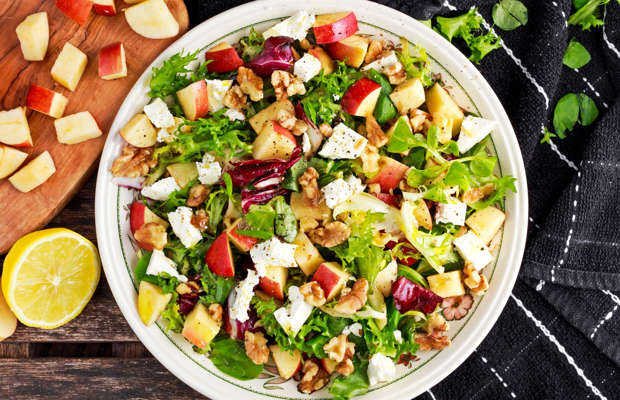
2. Building healthier eating habits.
Cutting back on ultra-processed foods is only difficult when you're unprepared (if you didn't eat breakfast, you'll want a donut in your morning meeting; if you didn't pack a snack, you'll go to the vending machine; if you didn't bring snacks for the road trip, you'll want a drive-thru … sound familiar?!).That said, building healthier eating habits is a process - it won't just happen overnight.
 © Hill Street Studios/Blend Images/Getty Images
GHNA is designed to help consumers through nutrition education (you see our label, you know it's promoting a healthy-eating habit) and by meeting you where you're at - both physically and emotionally. GHNA doesn't indicate diet food or deprivation; it denotes foods and food combos that are satisfying, and that can fit into your lifestyle seamlessly. The end result? Staving off the temptation to say "screw it" and going fistful-first into the fries/chips/burgers or gulping sugary sodas.
© Hill Street Studios/Blend Images/Getty Images
GHNA is designed to help consumers through nutrition education (you see our label, you know it's promoting a healthy-eating habit) and by meeting you where you're at - both physically and emotionally. GHNA doesn't indicate diet food or deprivation; it denotes foods and food combos that are satisfying, and that can fit into your lifestyle seamlessly. The end result? Staving off the temptation to say "screw it" and going fistful-first into the fries/chips/burgers or gulping sugary sodas.

3. Empowering consumers through education.
 © Steve Debenport/E+/Getty Images
When told to cut back on sugar and or salt, the first thing we hear at GH is "but I stopped eating dessert!" or, "I never add salt to my food!" But the problems in our food system go far beyond the baked goods and the salt shakers. They begin with the fact that American consumers are confused by marketing claims and ingredients-listed on food labels. In large part, that's because of a lack of transparency among many food products saturating the industry today. That's why we've made it our goal through GHNA to educate consumers by showing them what foods are truly what they claim to be. We're cutting through the supermarket clutter to show you what foods are made from real, simple ingredients that promote health. The ones that exploit certain health attributes through sexy marketing claims or use of trendy ingredients? Well, they simply don't qualify.
We know that cutting processed, sneaky sources of added sugar is key to making better food choices in the long-term - and that's why foods with added sugar by any name won't qualify for GHNA. We know which trends are fads (adding butter to coffee, juicing, and "gluten-free" everything) and which ones are health-promoting and here to stay (plant-based proteins, unsweetened beverages, and eating while on the go). That's why we're here to help cut the b.s. when it comes to what's marketed as "health food," and empower consumers through knowledge of which foods and food products are already out there to foster better eating habits - for the long term.
© Steve Debenport/E+/Getty Images
When told to cut back on sugar and or salt, the first thing we hear at GH is "but I stopped eating dessert!" or, "I never add salt to my food!" But the problems in our food system go far beyond the baked goods and the salt shakers. They begin with the fact that American consumers are confused by marketing claims and ingredients-listed on food labels. In large part, that's because of a lack of transparency among many food products saturating the industry today. That's why we've made it our goal through GHNA to educate consumers by showing them what foods are truly what they claim to be. We're cutting through the supermarket clutter to show you what foods are made from real, simple ingredients that promote health. The ones that exploit certain health attributes through sexy marketing claims or use of trendy ingredients? Well, they simply don't qualify.
We know that cutting processed, sneaky sources of added sugar is key to making better food choices in the long-term - and that's why foods with added sugar by any name won't qualify for GHNA. We know which trends are fads (adding butter to coffee, juicing, and "gluten-free" everything) and which ones are health-promoting and here to stay (plant-based proteins, unsweetened beverages, and eating while on the go). That's why we're here to help cut the b.s. when it comes to what's marketed as "health food," and empower consumers through knowledge of which foods and food products are already out there to foster better eating habits - for the long term.

4. Consciously indulging.
We're not about deprivation here at GH - we want you to have dessert, eat pizza, andbake brownies! But we want you to make these food choices consciously and from a place of empowerment - not because you've been mislead into believing something you're eating is good for you when its nutritional profile more closely resembles a candy bar (because if you were going to have candy for breakfast, why not have real candy, right?!). Consciously indulging means having the know-how to make smart, savvy choices that lead to health-promoting habits over time. But it's tough to indulge knowingly in today's food climate - there's simply too many marketing claims out there! GHNA eliminates the worry, and gives you permission to treat yourself.
 © IAN HOOTON/Science Photo Library/Getty Images
5. Working with food companies to make labels more transparent.
As much as it's our goal to educate and empower consumers to make strides in their health and wellness, we at GH are also aware of the fact that change doesn't happen overnight - and that's true for brands, too! That's why GHNA's incubator program for nascent and developed food companies is ready to work with food companies to help make their products work better for their consumers - not against them.We believe in the freedom that food companies have to market their products, but we also believe that in today's consumer market, nutritional quality of ingredients can be leveraged as a powerful marketing tool, too. Good nutrition for all means working together to make it happen. GHNA helps food companies improve their products' nutritional value and through marketing strategies that entice consumers with honesty and authenticity -n ot through misleading "health" claims.
© IAN HOOTON/Science Photo Library/Getty Images
5. Working with food companies to make labels more transparent.
As much as it's our goal to educate and empower consumers to make strides in their health and wellness, we at GH are also aware of the fact that change doesn't happen overnight - and that's true for brands, too! That's why GHNA's incubator program for nascent and developed food companies is ready to work with food companies to help make their products work better for their consumers - not against them.We believe in the freedom that food companies have to market their products, but we also believe that in today's consumer market, nutritional quality of ingredients can be leveraged as a powerful marketing tool, too. Good nutrition for all means working together to make it happen. GHNA helps food companies improve their products' nutritional value and through marketing strategies that entice consumers with honesty and authenticity -n ot through misleading "health" claims.

6. Making it easier to eat better. Period.
Some Ways That GHNA Does This
By recognizing brands that have ingredients and/or packaging that eliminate common barriers standing between you and healthier eating habits.
When you spot GHNA on food labels, you should think, "If I buy this, I'm making a choice that makes my life easier." Our most common examples of food products that help to simplify your get-healthy process: They require less cook time or less prep time; they're available at all gas stations; they're sold in to-go packs; they're affordable, they require less thought for what to feed my family for dinner; they help cut down on food waste, they provide a serving of veggies or fruit; they fit into my car's cup-holder, they get my kids excited about eating veggies…the list goes on.
 © DronG/iStock/Getty Images
By advocating for sustainability.
GHNA supports brands with products that are innovative in a category - namely in the realm of sustainability. or But we're also seeking brands that are looking to take steps toward becoming a more sustainable product (and already have begun the process to do so
By appealing to consumers of all ages.
Your kids and your parents love GHNA-foods equally because they taste delicious and they're easy to consume. Because what's the point of advocating for good-for-you food if no one wants to eat it?!
© DronG/iStock/Getty Images
By advocating for sustainability.
GHNA supports brands with products that are innovative in a category - namely in the realm of sustainability. or But we're also seeking brands that are looking to take steps toward becoming a more sustainable product (and already have begun the process to do so
By appealing to consumers of all ages.
Your kids and your parents love GHNA-foods equally because they taste delicious and they're easy to consume. Because what's the point of advocating for good-for-you food if no one wants to eat it?!

source : Good Housekeeping (http://www.goodhousekeeping.com/)
Related keywords : food climate, food choices, steve debenport, diet food, food combos, nascent and developed food, getty images, health food, ian hooton, helps food, food industry pioneers, food waste, gh nutritionist, food system, gas stations, food products, sustainable product, food, food labels

0 Comments